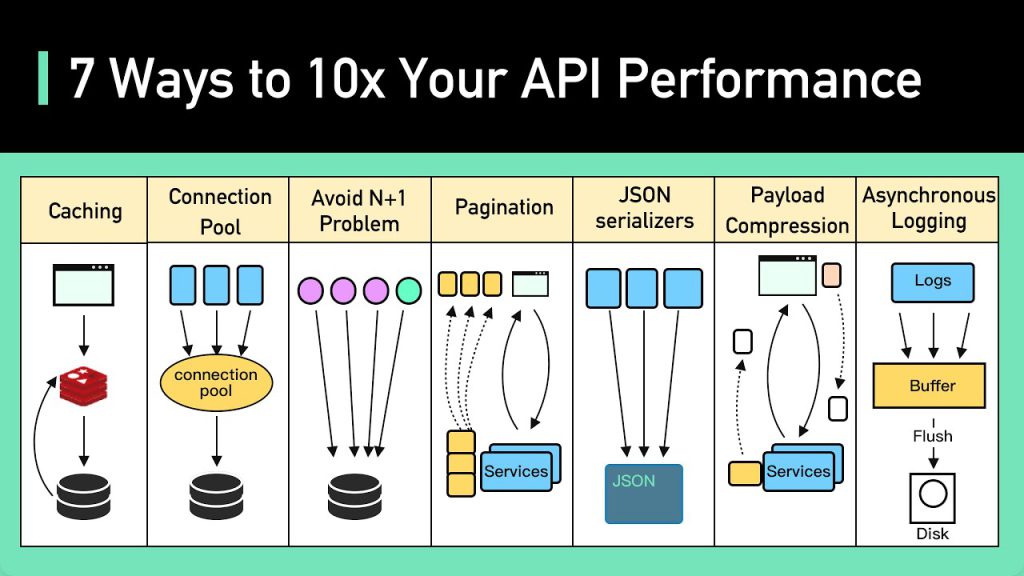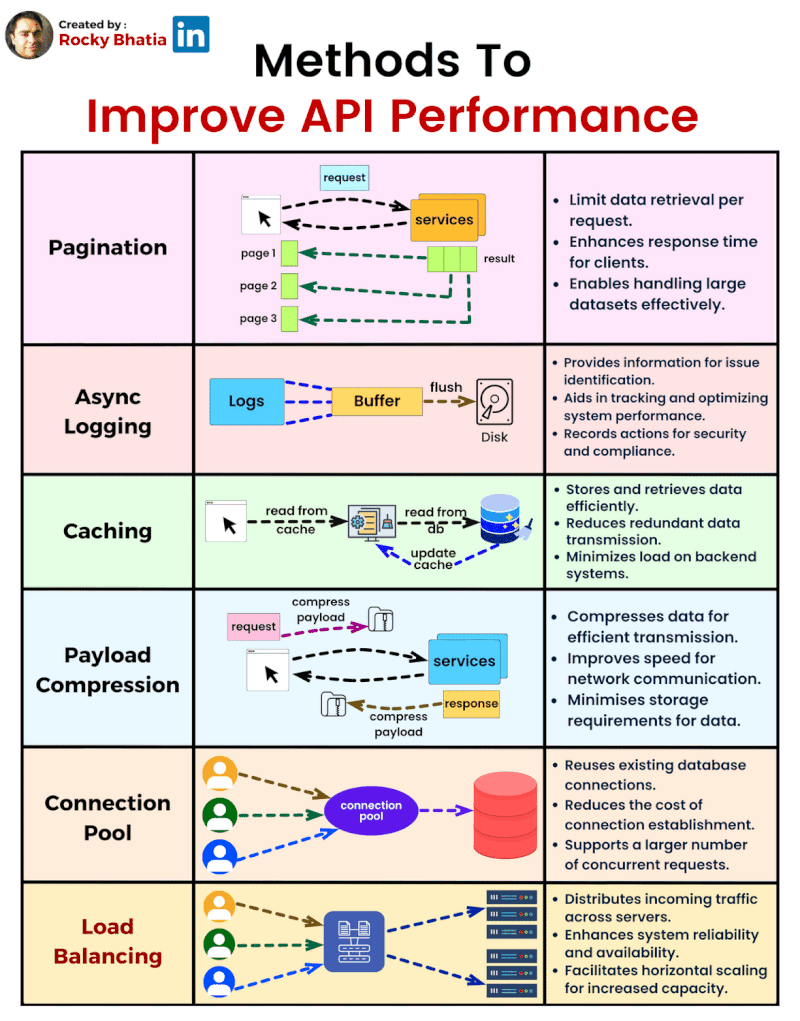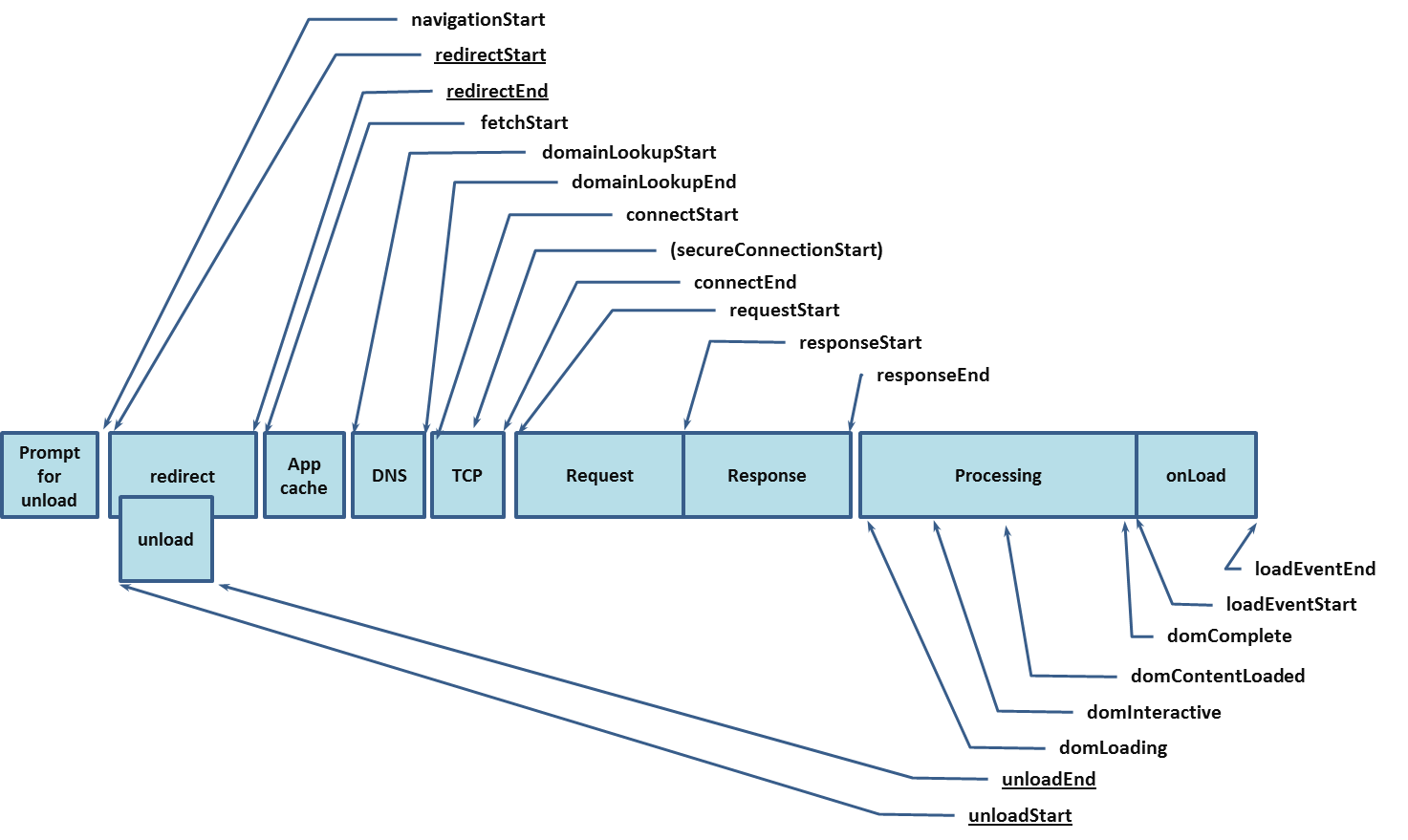
Improving API performance is critical for reducing latency, enhancing user experience, and optimizing resource consumption. Below is a detailed guide on all the methods you can use to improve REST, GraphQL, gRPC, and WebSocket APIs.
🔹 List of Methods to Improve API Performance
| Category | Optimization Techniques |
|---|---|
| 1️⃣ API Request Optimization | Reduce payload size, Compression, HTTP/2, Connection Pooling |
| 2️⃣ API Response Optimization | Caching, Gzip Compression, Minimize Headers |
| 3️⃣ Network & Protocol Optimization | HTTP/2, WebSockets, gRPC, TLS Termination |
| 4️⃣ Load Balancing & Scalability | API Gateway, CDNs, Auto-scaling |
| 5️⃣ Database Optimization | Indexing, Query Optimization, Read Replicas, Connection Pooling |
| 6️⃣ Security & Authentication Efficiency | Token Expiry, OAuth Optimization, Lightweight Encryption |
| 7️⃣ Logging, Monitoring & Debugging | API Observability, Distributed Tracing, Rate Limits |
| 8️⃣ Code & Infrastructure Optimization | Asynchronous Processing, Edge Computing, Serverless APIs |
1️⃣ API Request Optimization
Optimizing API requests reduces network overhead and improves response times.
✅ 1.1 Reduce Payload Size
📌 Why?
- Large request payloads slow down APIs due to higher network transfer time.
- JSON/XML-based APIs suffer from unnecessary fields & large objects.
📌 How to Optimize? ✔ Use Protobuf (for gRPC) instead of JSON for better efficiency.
✔ Use GraphQL for selective field fetching instead of REST over-fetching.
✔ Minimize unnecessary headers & avoid long query parameters.
📌 Example: Large vs. Optimized JSON Payload ❌ Bad (Unoptimized Payload)
{
"id": 12345,
"first_name": "John",
"last_name": "Doe",
"address": {
"street": "123 Main St",
"city": "New York",
"zipcode": "10001"
},
"extra_data": {
"unused_field_1": "...",
"unused_field_2": "..."
}
}
✅ Good (Optimized Payload)
{
"id": 12345,
"name": "John Doe",
"city": "New York"
}
✅ 1.2 Use Request Compression (Gzip, Brotli)
📌 Why?
✔ Compressing API requests reduces the payload size by 60-80%.
✔ Gzip and Brotli are widely supported compression methods.
📌 How to Enable Compression in APIs? ✔ Set Content-Encoding: gzip in HTTP headers.
✔ Enable gzip compression at API Gateway / Load Balancer level.
Example (Node.js Express API with Compression):
const compression = require('compression');
const express = require('express');
const app = express();
app.use(compression());
app.get('/data', (req, res) => {
res.json({ message: "Compressed response!" });
});
2️⃣ API Response Optimization
✅ 2.1 Implement Response Caching (Redis, CDN, API Gateway)
📌 Why?
✔ Caching avoids repeated database queries, reducing response time.
✔ Popular cache solutions: Redis, Memcached, API Gateway Cache, Cloudflare CDN.
📌 How to Implement? ✔ Use HTTP Caching Headers (Cache-Control, ETag).
✔ Use API Gateway Caching (AWS API Gateway, Fastly, Akamai).
Example (Cache-Control Header for API Responses):
Cache-Control: max-age=600, public
✅ 2.2 Use Response Compression
📌 Why?
✔ Reduces bandwidth usage and improves performance.
✔ Works for REST, GraphQL, gRPC APIs.
📌 How to Enable? ✔ Use Gzip (faster compression) or Brotli (better compression).
✔ Configure Nginx / Apache / API Gateway to auto-compress responses.
Example (Enable Gzip Compression in Nginx for API responses):
gzip on;
gzip_types application/json text/javascript;
3️⃣ Network & Protocol Optimization
✅ 3.1 Use HTTP/2 Instead of HTTP/1.1
📌 Why?
✔ Multiplexing (multiple requests in a single TCP connection).
✔ Reduces round-trip latency.
📌 How to Enable?
✔ Enable HTTP/2 on Load Balancer (AWS ALB, Nginx, Traefik).
✔ Use TLS encryption (HTTP/2 requires HTTPS).
✅ 3.2 Use WebSockets or gRPC Instead of REST
📌 Why?
✔ WebSockets are faster for real-time applications (e.g., chat, stock data).
✔ gRPC is faster than REST for microservices communication.
📌 How to Implement? ✔ Use gRPC APIs instead of REST for microservices.
✔ Use WebSockets instead of polling APIs.
Example (Node.js WebSockets API):
const WebSocket = require('ws');
const wss = new WebSocket.Server({ port: 8080 });
wss.on('connection', ws => {
ws.send('Hello Client!');
});
4️⃣ Load Balancing & Scalability
✅ 4.1 Use API Gateway & Load Balancers
📌 Why?
✔ Distributes API traffic across multiple backend servers.
✔ Prevents overloading a single API instance.
📌 Best API Gateways:
- AWS API Gateway (fully managed)
- Kong / Nginx API Gateway (self-hosted)
- Traefik (lightweight)
Example (Nginx Load Balancing for API Servers):
upstream api_servers {
server api1.example.com;
server api2.example.com;
}
server {
location /api {
proxy_pass http://api_servers;
}
}
5️⃣ Database Optimization
✅ 5.1 Optimize Database Queries (Indexes, Read Replicas)
📌 Why?
✔ Reduces query execution time from seconds to milliseconds.
✔ Prevents slow API responses.
📌 How to Optimize? ✔ Use Indexing (CREATE INDEX on frequently searched fields).
✔ Use Read Replicas for high-volume read operations.
Example (Create Index in MySQL):
CREATE INDEX idx_user_email ON users(email);
6️⃣ Security & Authentication Efficiency
✅ 6.1 Optimize Token Authentication (JWT Expiry & Caching)
📌 Why?
✔ Reduces repeated authentication calls.
✔ Prevents unnecessary API load.
📌 How to Optimize? ✔ Use short-lived JWT tokens with refresh tokens.
✔ Cache authentication tokens in Redis to reduce DB lookups.
Example (Short-Lived JWT Token):
const token = jwt.sign({ user: "John" }, secret, { expiresIn: "10m" });
7️⃣ Monitoring & Debugging
✅ 7.1 Use API Observability Tools
📌 Why?
✔ Helps identify slow APIs, bottlenecks, errors.
✔ Tracks latency, API usage, and failures.
📌 Best Monitoring Tools: ✔ Prometheus + Grafana (self-hosted monitoring).
✔ AWS CloudWatch (for AWS APIs).
✔ Jaeger / OpenTelemetry (for distributed tracing).
🚀 Final Checklist for Improving API Performance
✔ ✅ Reduce API request & response payloads
✔ ✅ Enable caching (Redis, API Gateway, CDN)
✔ ✅ Use HTTP/2, gRPC, or WebSockets for real-time APIs
✔ ✅ Load balance APIs (Nginx, AWS ALB, API Gateway)
✔ ✅ Optimize database queries & indexing
✔ ✅ Use API observability tools (Prometheus, Grafana, Jaeger)


I’m a DevOps/SRE/DevSecOps/Cloud Expert passionate about sharing knowledge and experiences. I am working at Cotocus. I blog tech insights at DevOps School, travel stories at Holiday Landmark, stock market tips at Stocks Mantra, health and fitness guidance at My Medic Plus, product reviews at I reviewed , and SEO strategies at Wizbrand.
Do you want to learn Quantum Computing?
Please find my social handles as below;
Rajesh Kumar Personal Website
Rajesh Kumar at YOUTUBE
Rajesh Kumar at INSTAGRAM
Rajesh Kumar at X
Rajesh Kumar at FACEBOOK
Rajesh Kumar at LINKEDIN
Rajesh Kumar at PINTEREST
Rajesh Kumar at QUORA
Rajesh Kumar at WIZBRAND

